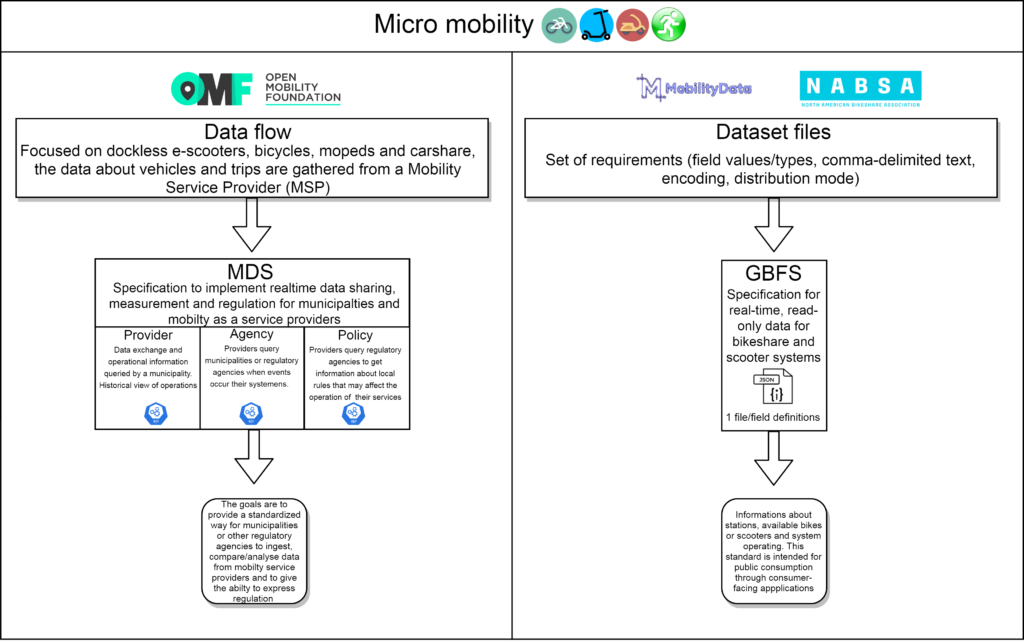The field of mobility data is highly standardised, with standards for static or real-time data in e.g. public transport, road traffic management and micro-mobility services. Journey planning applications and Mobility-as-a-Service also depend on standards, e.g. for exchanging ticketing information. However, challenges still exist in the progress towards standards and common protocols. The purpose of this section is to provide an overview about the standards themselves, the standardisation bodies behind them, and their current adoption.

Standards for sharing Public Transport data #
Public transport standards are related to the European Directive 2010/40 on Intelligent Transport Systems (ITS Directive) that aims to establish a framework for coordinated and effective deployment and use of ITS, set common priorities, develop specifications and standards. On the other hand, public transport standards are also related to the relevant Delegated Regulations concerning the several aspects of transport, i.e. Delegated Regulations on Road safety-related minimum universal traffic information free of charge to users (886/2013), EU-wide real-time traffic information services (2015/962), and EU-wide multimodal travel information service (2017/1926). The idea of these Regulations is to develop specifications to be followed in order to ensure the compatibility and interoperability among different systems and to provide all the information so that they are accurate and viable across borders. They indicate how to ensure a correct formal communication among member states and how to develop National Access Points (NAP).

1.1 De-jure standards for sharing public transport data #
De jure standards are definitions, descriptions or procedures defined by a group of experts and validated by a commission that can be national (e.g. AFNOR), European (CEN) or international (ISO). NeTEx and SIRI are public transport data exchange standards validated at European level by the CEN.
Transmodel #
Transmodel is the European Reference Data Model for Public Transport. It provides an abstract model of common public transport concepts and structures that can be used to compare and reconcile information architectures, databases and data exchange interfaces. This model also aims to build many kinds of public transport information systems, including for timetabling, fares, operational management, real time data, etc. It can be compared to a dictionary which describes the public transport wording and, above all, the links between all these terms.
NeTEx (Transmodel standard) #
Network Timetable Exchange (NeTEx) is a CEN Technical Standard for exchanging public transport network, schedules and related data. It provides a means to exchange data for passenger information such as stops, routes timetables and fares, among different computer systems, together with related operational data.
SIRI (Transmodel standard) #
Service Interface for Real-time Information (SIRI) is a CEN Technical Standard13 that specifies a European interface standard for exchanging information about the planned, current or projected performance of real-time public transport operations between different computer systems. It allows pairs of server computers to exchange structured real-time information about schedules, vehicles, and connections, together with general informational messages related to the operation of the services.
1.2 De-facto standards for sharing public transport data #
De facto standards are definitions, descriptions, or procedures which have been imposed by usage, most often by a commercial will and force. GTFS Schedule, GTFS Realtime and GBFS are widely used de facto standards worldwide.
The General Transit Feed Specification (GTFS) data format contains two parts, the GTFS Schedule component (based on the CSV data format) and the GTFS Realtime component (based on Protocol Buffers data format).
GTFS Schedule #
The GTFS Schedule component, also known as GTFS “Static”, defines a common format for public transportation schedules and associated geographic information. GTFS Schedule datasets let public transit agencies publish their transit data and developers write applications that consume that data in an interoperable way. A GTFS dataset is composed of a series of CSV text files collected in a ZIP file. Each file models a particular aspect of transit information: stops, routes, trips, and other schedule data. The details of each file are defined in the GTFS reference
GTFS Realtime #
GTFS Real-time is a component of GTFS (General Transit Feed Specification), which is a specification that allows public transportation agencies to provide real-time updates about their fleet to application developers. GTFS Realtime was designed around ease of implementation, good interoperability with GTFS Schedule and a focus on passenger information. GTFS Realtime is lighter and therefore more efficient to process in real time than SIRI. The GTFS Realtime data exchange format is based on Protocol Buffers. Protocol Buffers are a language – and platform – neutral mechanism for serialising structured data (think XML, but smaller, faster, and simpler).
1.3 Journey planning #
Operating Raw Data and statistics exchange (OpRa) #
Operating Raw Data and statistics exchange (OpRa) is a CEN initiative with main focus on the identification of Public Transport raw data to be exchanged, gathered and stored in order to support Study and Control of Pubic Transport Service. This standard is currently in progress and in the long run, the work will consist in the production of a Technical Report, to document the results of the performed analysis. It will describe the recorded reality of operation, like delays and cancelled vehicle journeys, etc. either through individual measurements at a given sampling interval or in an aggregate ways (statistics).
Open Journey Planning (OJP) Open API for distributed journey planning #
The requirement to exchange accurate and timely information about public transport services and to implement systems able to provide multi-modal information for longer-distance journeys is crucial. Several systems have been developed to meet this requirement, based on different architectures, but the nature of the queries sent between the systems, and the content of the responses sent in return, were essentially the same. This suggests that it would be possible to define a single Open Journey Planning (OJP) API to support all distributed journey planning systems. OJP allows a system to engineer just one interface that it can make available rather than having to engineer separate APIs for each bipartite exchange arrangement that may be required with other systems.
1.4 Public transport data sharing standards in MobiDataLab #
The interest of the public transport standards for MobiDataLab are obvious as the goal of the project is to provide access to public transport data to be re-used by developers and innovators during innovation sessions, and to be able to transcode them.
Standards for sharing road traffic data #
Road network operators, who are responsible for traffic management, travel safety, road conditions maintenance and user information, need good traffic knowledge, which is why quality traffic data is needed. Also, road users need to get fresh map data from the road operators to the vehicle’s navigation systems. Sharing road traffic data actually depends on standards, like the DATEX II and TN-ITS.

2.1 DATEX II #
DATEX II is the European standard for the exchange of traffic related data. It is a unified XML based format to allow data exchange between service providers, traffic control centres, and road operators. It covers traffic and travel information such as traffic flow, traffic measures, roadworks, accidents, parking.
2.2 TN-ITS #
The TN-ITS CEN is a technical specification describing the exchange (of changes) of road attributes, emphasising on static road data, such as speed limits. It is maintained by the CEN, under their Technical Committee “Road Transport and Traffic Telematics (TC278)”. The specification is built on top of the Geographic Markup Language (GML), which is an XML standard.
2.3 Road traffic data sharing standards in MobiDataLab #
Road traffic standards in general and, DATEX II in particular, are relevant for MobiDataLab for the use cases about data analytics, Estimated Time of Arrival (ETA), and particularly in cases of traffic incidents. MobiDataLab will use DATEX II integrating it with the HERE platform (Real-Time Traffic API), establishing an interoperability with available streaming data.
Standards for sharing micro-mobility data #
Most of the shared micro-mobility services available in many cities across Europe and beyond are using bicycles, e-scooters and other small devices. These vehicles can be found in fixed stations, or “free-floating” in public spaces (i.e., not fixed to specific locations). According to the report by MobiDataLab partner POLIS (https://www.polisnetwork.eu/wp-content/uploads/2021/01/SHARING-DATA-FROM-SHAREDMICROMOBILITY_FINAL.pdf ) , “digital technologies and geolocation play a central role in these services, and their operation generates high volumes of data, about the number, spatial distribution, and status of these vehicles, but also about who is using them, to travel where, and when.” Two standards are mainly used to share the corresponding data: GBFS and MDS.

3.1 MDS (Mobility Data Specification) #
The Mobility Data Specification (MDS), a project of the Open Mobility Foundation (OMF), is a set of APIs focused on dockless e-scooters, bicycles, mopeds and carshare. The goals of MDS are to provide a standardised way for municipalities or other regulatory agencies to retrieve, compare and analyse data from mobility service providers, and to give municipalities the ability to express regulation in machine-readable formats. MDS helps cities interact with companies who operate dockless scooters, bicycles, mopeds and carshare in the public right-of-way. MDS is a key piece of digital infrastructure that supports the effective implementation of mobility policies in cities around the world.
3.2 GBFS (General Bikeshare Feed Specification) #
The General Bikeshare Feed Specification, known as GBFS, is the open data standard for shared mobility, including shared bicycles, mopeds, scooters, and cars. GBFS is used to produce real-time data feeds in a uniform format, with an emphasis on discoverability. GBFS is intended to make shared mobility information publicly available online. Therefore, any piece of information that can result in a suer being personally identifiable is not currently and will not become part of the core specification. GBFS was created in 2014 to describe traveller facing information of a shared mobility system. As its name suggests, GBFS is inspired by GTFS, with a similar process for governance, similar openness to the industry needs and with the similar principle that any proposed change to the specification must be produced and consumed by the industry.
3.3 Micro-mobility data sharing standards in MobiDataLab #
Micro-mobility and shared mobility standards are obviously relevant for MobiDataLab as the challenges proposed to the Living Labs participants will be provided by referring municipalities who face concrete mobility problems and data sharing issues with these new mobility modes in a urban context.
Standards for sharing ticketing data #

Many public transport systems collect fares using proprietary contactless technologies. Potential disadvantages of such proprietary systems (like e.g. vendor lock-in) can be detrimental to operators, transport agencies and also to the end-user. On the contrary, solutions based on open standards can create a solid foundation for secure and efficient transport ticketing and multiapplication systems. The most popular open standards are Calypso and CIPURSE.



